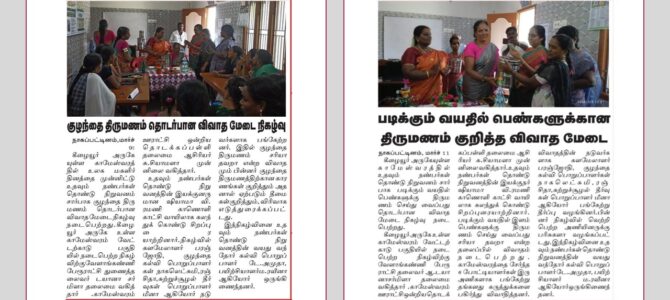The International Women’s Day debate on early marriage versus pursuing higher education was a success, as mentioned in our previous post. However, we were surprised to see that local newspapers reported it as a debate on “child marriage.” Amutha Ma’am called them to inquire why, and the reporters explained, “Ma’am, we sent the photos along with a message about who had attended the event, and the editor chose the titles.” Then very kindly, the reporters got the headlines changed!
While this confusion may seem strange, it’s not entirely unexpected. A primary issue debated in public forums regarding marriage often revolves around age. So, what’s the problem?
Child marriage, defined as marriage before the age of 18, is prevalent in many low- and middle-income countries. According to UNICEF, an alarming 12 million girls worldwide are married off before reaching the age of 18 each year. India alone accounts for approximately 27% of global child marriages, as reported by Girls Not Brides.
Leading human rights organisations, such as the United Nations Convention on the Rights of the Child (CRC) and the Convention on the Elimination of All Forms of Discrimination Against Women (CEDAW), argue that child marriage violates fundamental rights, including access to healthcare, education, and protection from harm. Therefore, they advocate for setting the legal marriage age at 18 universally, without exceptions. However, even today, countries such as Iran allow for girls as young as 13 and boys at 15 to marry under certain conditions, like parental consent or judicial approval.
The prevalence of child marriage is influenced by a combination of factors, including cultural practices, poverty, patriarchal norms, and limited education opportunities. For instance, in regions like Sub-Saharan Africa, child marriage rates remain high due to traditions prioritising early marriage for girls. Similarly, in parts of South Asia, economic hardships and social norms contribute to the persistence of child marriage practices, where 1 in 4 women are married before the age of 18, even in 2023, according to UNICEF.
In this context, to eliminate child marriage and empower women, most countries have a set minimum age requirement for marriage. In most high-income nations, such as the Netherlands, Germany, and France, the legal age for marriage is 18 years, considered a benchmark for maturity and informed decision-making. However, exceptions exist in some countries. For instance, in the United States, while most states set the minimum age at 18, exceptions allow marriages as young as 16 in states like Kansas, according to the World Population Review.
Interestingly, at present, India has among the highest minimum age requirements for marriage in the world. But going back in history, the Child Marriage Restraining Act, introduced in 1930 by the British colonial rulers, set the minimum legal marriage age at 14 for females and 18 for males. After Indian independence in 1947, the newly elected government amended this inherited law, increasing the minimum legal marriage age for females to 15 in 1949. Later, in 1978, the minimum age for marriage was further raised to 18 for women and 21 for men. Then, in 2021, the Indian government made another big change, increasing the minimum legal age for marriage to 21 for both men and women under the Prohibition of Child Marriage Bill of 2021. This decision was motivated not only by the need to curb child marriages but also to encourage households to educate their female children and/or have work experience before marriage. This measure is further backed up by a law introduced in 2017 (Act 26), by which individuals conducting or abetting child marriages would be subject to up to two years in jail along with a fine of up to 1 lakh rupees (€1,100).
Now, while some view the new minimum marriage age law as an opportunity to raise awareness in communities and society for women’s empowerment, it has sparked debate too. Indeed, some women’s activists perceive it as a futile step or perhaps even a detrimental step, arguing that it encroaches upon the autonomy of young Indian men and women to marry, even after being able to vote! So, will this new law really lower child marriages in India and contribute to women’s empowerment? Nobody knows—only the future will tell! At any rate, in addition to legislative measures, initiatives focusing on empowering girls, expanding educational access, and raising awareness about the adverse effects of early marriage are absolutely crucial to combat this societal challenge.
Extra Resources:
UN data on country-specific child marriage laws:
Specific laws on Child marriages from all around the world – comprehensive report by the PEW research center:


